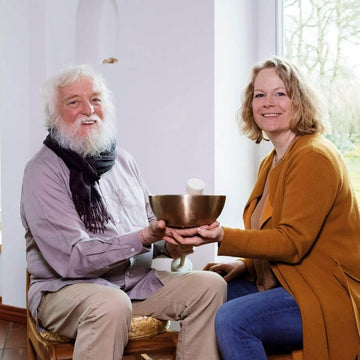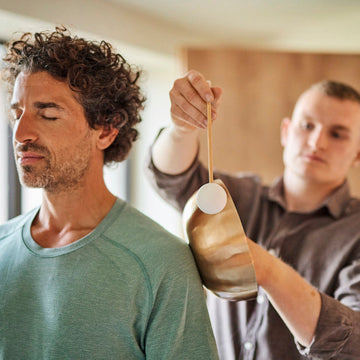Peter Hess® Sangha, Assam and Zen Singing Bowls
Product Safety Regulation (GSPR)
These product safety instructions are for the sustainable handling of our Peter Hess® Sangha Singing Bowls.
In the production of Singing Bowls, which we initiated in Nepal more than 15 years ago, these are hand-forged from a bronze alloy using the pure metals copper and tin. Depending on the Singing Bowl type, the round shape varies in height, diameter, wall thickness and weight (0.7kg - 2.5kg), allowing for different pitches and sound characteristics.
Since each Singing Bowl is unique, certain deviations from the parameters we define are possible for each Singing Bowl type. In addition, each Singing Bowl has individual characteristics resulting from the manufacturing processes. This includes, for example, slight scratches, discolorations or small inclusions of coal. However, these characteristics do not affect the sound character of the Singing Bowls, which undergo several quality checks before being sold.
Due to the nature of bronze, the Singing Bowl can react to the environment, especially in humid conditions, and tarnish (partially). This is a natural process and can also be caused by dirt from regular use, as well as from touching it with hands and fingers, if the Singing Bowl is not cleaned regularly and/or stored in its supplied protective fabric cover. However, any patina that forms on the metal has no effect on the sound properties of the bowl.
Each of our Singing Bowls undergoes several quality controls to ensure there are no material or manufacturing defects and to guarantee a corresponding sound quality. After successful testing, our Hess Sound quality seal is always placed inside the Singing Bowl, indicating the respective quality level (“Premium” or “Classic”). The Singing Bowls have an EAN code on their paper packaging, and we pack them exclusively in recycled paper and with cushioning flakes made of potato starch in cardboard boxes.
The Singing Bowls should be struck mindfully and not too loudly, as some vibrate in a frequency spectrum that can be perceived as unpleasant at an insufficient distance from the ear. The Singing Bowl can be played by people of all ages, but due to its possible sound volume, weight and metallic composition, it should only be played by children under the supervision of adults until a safe handling has been learned. Care should also always be taken to ensure that the bowl is positioned safely, as some specimens are naturally quite heavy.
Beyond their intended use as relaxation, meditation, music, or therapy instruments, a Singing Bowl can be used for decorative purposes. However, it should not be used as a dish for food, a container for storing food, or a place to keep liquids.
If the Singing Bowl should fall on the floor from a greater height, it can break or crack due to the inherent material tension. Usually, this only creates a crack of a few centimeters inside the bowl, and sometimes it can still be played afterwards.
If your Singing Bowl is irreparably damaged, you are welcome to return it to Hess Sound GmbH & Co. KG – we will then take care of the disposal.
Peter Hess® Assam & Zen Singing Bowls and Cymbals
These product safety instructions are for the sustainable handling of our Peter Hess® Assam & Zen Singing Bowls and cymbals.
The Assam & Zen Singing Bowls and Zen Cymbals we manufacture in India are cast from an alloy of copper and tin . Depending on the type, the round shape varies in diameter (4.5 -12.5cm) and weight, which results in different pitches and sound characteristics.
During the manufacturing process, Singing Bowls and cymbals may exhibit individual characteristics. These include, for example, slight scratches, discolorations, or small inclusions of carbon. However, these characteristics do not affect the sound quality of the Singing Bowls, which undergo several quality checks before sale.
The Singing Bowls and cymbals should be cleaned regularly and/or stored in a protective cover made of fabric. However, any patina that may form on the metal has no influence on the sound behaviour of the bowl.
Each of our Singing Bowls undergoes several quality controls to ensure there are no material or manufacturing defects and to guarantee a corresponding sound quality. After successful testing, our Hess Sound quality seal is always placed inside the Singing Bowl. The Singing Bowls have an EAN code on their paper packaging, and we pack them exclusively in recycled paper and with cushioning flakes made of potato starch in cardboard boxes.
The Singing Bowls and cymbals should be struck mindfully and not too loudly, as they vibrate in a high frequency spectrum that can be perceived as unpleasant at an insufficient distance from the ear. The Singing Bowl can be played by people of all ages, but due to its possible sound volume, weight and metallic composition, it should only be played by children under the supervision of adults until a safe handling of it has been learned. Care should also always be taken to ensure that the bowl is positioned safely, as some specimens are naturally quite heavy.
Beyond their intended use as relaxation, meditation, music, or therapy instruments, Assam & Zen Singing Bowls and cymbals can be used for decorative purposes.
If the Singing Bowl or cymbals should fall on the floor from a greater height, they can break due to the inherent material tension. If your Singing Bowl or cymbals are irreparably damaged, you are welcome to return them to Hess Sound GmbH & Co. KG – we will then take care of the disposal.






